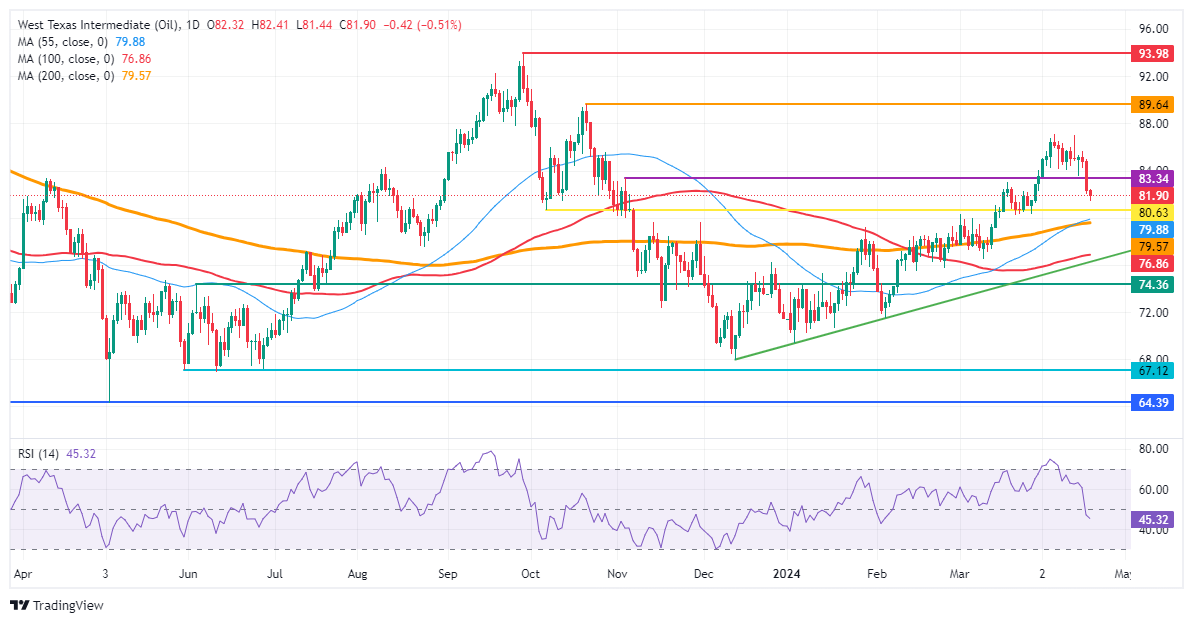Oil sinks over 3% in two trading days despite sanction risks against Iran
- WTI Oil sell-off persisted on Thursday, posting 3% losses in two trading days.
- Oil prices broke below the pivotal $83.34 level, heading to $80.63 next.
- The US Dollar Index slides below 106.00 after a slew of central bankers are pushing against a stronger Greenback.
Oil prices retreat further on Thursday, extending the decline triggered on Wednesday after a string of headlines from the US President Joe Biden administration over tariffs and sanctions. On the tariff front, Biden called for higher fees on Chinese steel and aluminium. On the sanctions front, the US is set to reimpose sanctions on Venezuelan Oil and Gas while Washington considers adding sanctions on Iran’s Oil exports.
The US Dollar, meanwhile, is facing pressure from several central banks across the world that are seeing their currencies depreciate against the US Dollar. The strength of the US Dollar is an issue for central banks as it trickles back inflation. In Asia, even a coordinated intervention could take place should the US Dollar Index (DXY) rally any further with Japan and South Korea set to jointly intervene in markets.
Crude Oil (WTI) trades at $81.80 and Brent Crude at $86.44 at the time of writing.
Oil news and market movers: sanctions ahead
- Recent data shows that Iran is exporting the highest amount of Oil in more than six years, the Financial Times reports.
- China is set to have a surplus of Oil production, expanding to 82m tons by 2030, according to Li Ran, a researcher at CNPC’s Economics & Technology Research Institute. This surplus would make up for any shortfall in the markets from OPEC and other suppliers.
- Leading Goldman Sachs Analyst Daan Struyven sees $90 as a ceiling for Brent Crude.
- The recent Crude Oil Inventories report from the US Energy Information Administration (EIA) showed that the Gulf Coast stockpiles are at their highest level in a year. Us Inventories grew by 2.74 million barrels, the highest since June 2023.
Oil Technical Analysis: Easing for now with tail risk in mind
Oil prices are not rallying despite the current stance from the Biden administration with sanctions being slapped on Venezuela and are set to be issued for Iran, which should be rather supportive for Oil prices. On the production front, Iran is number 3 and Venezuela is number 9 on oil production volumes within OPEC. Sanctions on Iran thus might be having a heavier impact on prices than the ones for Venezuela, which means the Biden administration will probably sanction non-oil sectors in order to avoid disruptions in the global Oil supply.
With geopolitical tensions lingering, the $83.34 and $90 handle should remain in grasp. One small barrier in the way is $89.64, the peak from October 20. In case of further escalating tensions in the Middle East, expect even $94 to become a possibility, and a fresh 18-month high could be on the cards.
On the downside, $80.63 is the next candidate as a pivotal supportive level. A touch softer, the convergence with the 55-day and the 200-day Simple Moving Averages (SMAs) at $79.88 and $79.57 should halt any further downturn.
US WTI Crude Oil: Daily Chart
WTI Oil FAQs
WTI Oil is a type of Crude Oil sold on international markets. The WTI stands for West Texas Intermediate, one of three major types including Brent and Dubai Crude. WTI is also referred to as “light” and “sweet” because of its relatively low gravity and sulfur content respectively. It is considered a high quality Oil that is easily refined. It is sourced in the United States and distributed via the Cushing hub, which is considered “The Pipeline Crossroads of the World”. It is a benchmark for the Oil market and WTI price is frequently quoted in the media.
Like all assets, supply and demand are the key drivers of WTI Oil price. As such, global growth can be a driver of increased demand and vice versa for weak global growth. Political instability, wars, and sanctions can disrupt supply and impact prices. The decisions of OPEC, a group of major Oil-producing countries, is another key driver of price. The value of the US Dollar influences the price of WTI Crude Oil, since Oil is predominantly traded in US Dollars, thus a weaker US Dollar can make Oil more affordable and vice versa.
The weekly Oil inventory reports published by the American Petroleum Institute (API) and the Energy Information Agency (EIA) impact the price of WTI Oil. Changes in inventories reflect fluctuating supply and demand. If the data shows a drop in inventories it can indicate increased demand, pushing up Oil price. Higher inventories can reflect increased supply, pushing down prices. API’s report is published every Tuesday and EIA’s the day after. Their results are usually similar, falling within 1% of each other 75% of the time. The EIA data is considered more reliable, since it is a government agency.
OPEC (Organization of the Petroleum Exporting Countries) is a group of 13 Oil-producing nations who collectively decide production quotas for member countries at twice-yearly meetings. Their decisions often impact WTI Oil prices. When OPEC decides to lower quotas, it can tighten supply, pushing up Oil prices. When OPEC increases production, it has the opposite effect. OPEC+ refers to an expanded group that includes ten extra non-OPEC members, the most notable of which is Russia.







